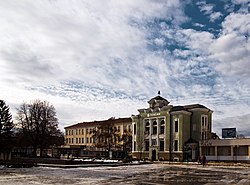Targovishte
|
Targovishte Търговище |
||
|---|---|---|
| City | ||
 |
||
|
||
| Location of Targovishte | ||
| Coordinates: 43°15′N 26°35′E / 43.250°N 26.583°E | ||
| Country | Bulgaria | |
| Province (Oblast) | Targovishte | |
| Municipality | Targovishte | |
| Government | ||
| • Mayor | Darin Dimitrov (GERB) | |
| Area | ||
| • City | 87.427 km2 (33.756 sq mi) | |
| Elevation | 170 m (560 ft) | |
| Population (2012) | ||
| • City | 37,341 | |
| • Density | 430/km2 (1,100/sq mi) | |
| • Urban | 56,868 | |
| Time zone | EET (UTC+2) | |
| • Summer (DST) | EEST (UTC+3) | |
| Postal Code | 7700 | |
| Area code(s) | 0601 | |
| License Plate | T | |
| Website | Official website | |
Targovishte (Bulgarian: Търговище, Tǎrgovište) is a city in Bulgaria, the administrative and economic capital of Targovishte Province.
It is situated at the northern foot of the low mountain of Preslav on both banks of the Vrana River. The town is 335 kilometres (208 miles) north-east of the capital Sofia and about 125 km (78 mi) west of the city of Varna and Bulgarian Black Sea Coast. Targovishte is known as an old market settlement.
The name comes from the Slavic root targ ("trade") + the Slavic placename suffix -ishte, "market town" (a calque of the Ottoman Turkish Eski Cuma, "old market", though the Turkish name may be derived from the earlier Bulgarian Sborishte "rendezvous, venue").
Archaeological studies prove that in these places there were people in the Cooper-Stone Age (Chalcolithic) – between the 5th and the 4th millennium BC. In the city's vicinity are the remains of Thracian settlements (5th–3rd century BC), a Roman settlement (2nd–4th century AD) and a fortress from the early Byzantine period (5th–6th century). A Bulgarian settlement was founded in the 10th century during the First Bulgarian Empire, however due to its proximity to the capital Preslav, it did not develop until the 12th century. In the 12th century, due to its location on a main road from the new capital Veliko Turnovo, a fortress by the name "Сборище" (Sborishte) was built.
In the 18th and 19th centuries it became a famous market for animals and craft products called Eski Cuma ("old bazaar" in Turkish). A monastical school was opened in the 18th century and a secular one, called the Slaveykov School and situated in the old Varosha Quarter was established in 1846, with Petko Slaveykov being a teacher there; a chitalishte was also built. Industrial development began after the Second World War. Factories producing car batteries and machines for the food industry were opened; later, furniture and textile industries developed. One of Bulgaria's largest wine production factories is located there. Targovishte is home to one of the largest glass factories in Europe. The investment in the factory was $380,000,000 and employs 1,500 people.
...
Wikipedia


